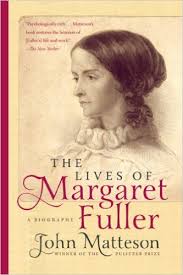Hearing two sermons on Margaret Fuller inspired me to read The Lives of Margaret Fuller by John Matteson. In his preface, Matteson explains the biography’s title. To give a sense of the complexity of this woman’s life and character, he presents them “…as a succession of lives, each one building on those previously lived…” A partial list of chapter titles – Prodigy, Misfit, Apostle, Advocate, Lover, and Critic – indicates the focus.
In her time, Margaret Fuller was “…the best read woman in America…most renowned for her intelligence…first regular foreign correspondent…,”and the list of her accomplishments continues. She was celebrated for her brilliance and goodwill, “…but she could also be arrogant, irritable and condescending, …shockingly neglectful of those in direst need of her attention.”
She spent her childhood fulfilling her father’s ambitious educational agendas but she lost the chance to be a child and learn the skills of socialization. Matteson traces her progression as a misfit unable to socialize with her peers, to an impoverished young woman forced to support herself. Through her enormous hunger for knowledge, her innate brilliance, and her willingness to transform herself as the occasion required, she achieved the recognition she sought as the intellectual equal of her male counterparts.
An additional pleasure of this book is a description of her mostly uneasy relationships with Emerson, Bronson Alcott, Horace Greeley, and Nathanial Hawthorne, among others. Matteson’s descriptions of their interchanges humanize these American luminaries.
The Lives of Margaret Fuller is a beautifully written account of a complicated woman making her uphill way in early 19th-century America. At almost 500 pages, this biography is not a quick read. Instead, it is a book to be mulled over and savored. An added benefit for us UUs is that by reading about her life as she participates in the transcendental and Unitarian movements of the period, we are introduced to the American roots of our church.
Judy DeGraaff, October 2013

